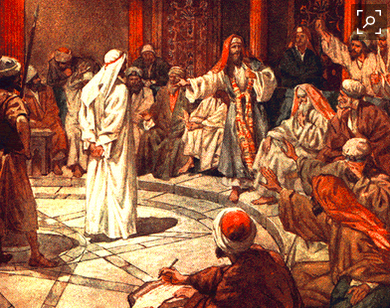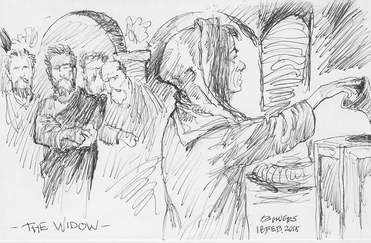 A Household Table-Waiter Preaches. Luke’s story of Stephen’s sermon before Jewish leaders (Acts 6:1–7:60) is framed by the gathered-church household-venue (5:42; 8:3; cf. 2:46). At some point the widows of Hellenist converts were being overlooked in the daily serving of food (Acts 6:1c) at the deipnon (i.e., supper) component of the gathered-church. The Acts 6 setting assumes a house-venue (from house to house, Acts 5:42) where the Greek-speaking widows were to have found a place at table (certainly a trajectory application of the distributed Spirit upon aged women!) As a response, the twelve (apostles) determined their role was prayer and the ministry of the word (Acts 6:2) and that reputable, Spirit-filled men were to be selected to serve (diakoneō) tables at the deipnon and care for the widows. Men! Not slaves. Not women. This was an astonishing trajectory application of the gospel and the inaugural distribution of the Spirit. Men did not do this in a Greco-Roman household. Furthermore, when Luke choose his very first scene afterward for the “ministry of the word,” he does not pick one that included an apostle; it was a table-waiting lay-person from among the household gathered-church, Stephen. Furthermore, we should not treat lightly the “house” theme in table-waiter Stephen’s defense before temple-leadership, for he draws upon a text that deconstructs temple-imagery and his trajectory application constructs God’s new dwelling of “house.” Stephen quotes Isaiah’s words to Jewish exiles to stress that the Most High does not dwell in anything made by human hands (cheiropoiētois): ‘Heaven is My throne, Given Luke’s “house” theme elsewhere,[1] it is not a stretch to answer the Isianic question--What kind of house will you build for Me?—by pointing to the newly distributed Spirit among the household gathered-churches. And, after Stephen is stoned (Acts 7:54–60), Luke’s narrative pans straightaway back to the house church venue as Saul makes his arrests from house to house (8:3). The first narrative contrast to the temple is the new resting place of God among believers, that is “house to house.” [1] Note the 14 house-banquets in the Gospel of Luke and the numerous occasions in Acts. This is a thread consisting of parts of a a recent paper presented at the 2017 Evangelical Theological Society's annual meeting in Providence, RI. The goal is to develop an anthology of essays (by various authors) on the subject, Christian Responses to Tyranny. Part 1 | Part 2a | Part 2b | Part 2c | Part 3 | Part 3a | Part 3b | Part 4a | Part 4b | Part 5 For the entire thread (remember to scroll backwards for previous posts) << Gathered-church >>
0 Comments
 There is some irony to the two typical reactions (that is, the two interpretations) to the story, which I call the poor widow vs. duplicitous scribes episode: one holds it up as an example of faithful devotion and sacrificial giving, while the other sees judgment, lament, and tragedy. Everything about this short story, in Mark 12, suggests that the widow is being taken advantage of by a temple leadership that does not have her best interests in mind. Although it might be advantageous for churches and Christian ministries to see the poor widow as an example of sacrificial giving, this interpretation, however, turns the text 180 degrees contrary to its context and is disconnected from the plot Mark has developed through his Gospel narrative. This leads to a failure of interpretation that distracts the Christian community from developing biblically authoritative and analogous application from this text. This episode fits within Mark’s paradigm for Christian discipleship; but, what does it require of the Christian community? How does it inform the Christian call to discipleship? Is the widow the focal point, or is the failure of temple leadership the crux of the story that should form the church’s understanding of discipleship? Mark does draw a narrative correspondence between the widow giving her whole life [my translation for holon ton bion autēs, 12: 44c] and Jesus’ imminent sacrifice, the giving of his own life. Some take this to mean that “we, too, should give our lives and resources sacrificially like the widow and Jesus.” No! This is an inappropriate analogy and is an ill-fitted correspondence to the text and its context. While the link to Jesus is certainly there in the Gospel story, the larger issue is the burden that was improperly, even maliciously, laid on the poor widow by the temple establishment—the poor widow should not have had to give her whole life (v. 44c). This is the point here: as God’s representatives, the scribes and, as well, the whole of temple leadership should have been her advocates, not the cause of her destitution. The link to Jesus is simply that he will step up to be her advocate and will give his life on her behalf.
Jesus’ observation of a poor widow who had given the last of her financial resources for which her whole life depended can just as equally be read as “downright disapproval” [Addison Wright] and not as praise. The contrast between the scribes and the widow is not about piety, but for illustrating and emphasizing the duplicitous conduct of the scribes. It is lamentable to watch this act of the poor widow in the presence of such wealth and religious duplicity. We can fail to notice there is a tragedy happening that day, right there in the temple courts. *From “Widows in Our Courts (Mark 12:38–44): The Public Advocacy Role of Local Congregations as Discipleship,” chapter 1 of Wasted Evangelism. All royalties from sales of Wasted Evangelism is given to support our church planting efforts and ministry in The Hill community of New Haven, CT.
 Often much is made of the coinage, the two mites, in the Poor widow story in Mark 12 (see v. 42). Many assume, too quickly, that the widow’s offering is placed “voluntary” in one of the thirteen trumpet-shaped vessels used to receive the various offerings by those entering the temple courts. Some offerings were obligatory, related to the temple tax and sin offerings; some were free-will and contributions of charity. Nothing in the text necessitates that the widow’s offering was voluntary. In fact, the scene and the wider context suggest that the two coins (leptons), which equaled a quadran, were more likely related to the temple tax or sin offering than to the voluntary free-will offering. The widow’s offering was worth less than one hundredth of a denarius or one hundredth of a day’s wage. This amount was capable of purchasing a “handful of flour.” According to OT Levitical provisions, if someone’s means are insufficient for even the two turtledoves or two young pigeons, then a tenth of an ephah of fine flour may be substituted for the sin offering (Lev 5:11; 14:21–32). Interestingly, there is also evidence that some temple authorities had viewed the offering of flour with contempt: Once a woman brought a handful of fine flour, and the priest despised her, saying, “See what she offers! What is there in this to eat? What is there in this to offer up?” It was shown to him in a dream: “Do not despise her! It is regarded as if she had sacrificed her own life” (Lev. Rab. 3.5).  The presence of the two coins in the scene emphasizes the widow’s condition of poverty and suggests her disadvantage (her standing or status) before the leaders in the temple courts, who were to be her advocates, but only had contempt for her. In addition to experiencing the loss of her spouse, making the widow one of the more vulnerable in Israel, she had been placed into this humiliating predicament by the established authorities and their banking system. The people and system had rendered her estate/house “devoured” by requiring the widow to contribute to that very system her remaining means (i.e., the last of her funds) to live. Jesus condemns the duplicitous temple leadership, their malicious behaviors (12:40c), and the temple system (13:2) that worsened the poor widow’s condition (12:44c) and left her resources now completely “devoured,” which was represented in the poor widow giving her last two coins. Note: Another possible reading for the contrast Jesus made between the surplus of the wealthy and the widow’s last two coins might suggest that those with the surplus have an oblivious detachment (malicious or banal) from the plight of the poor widow whose life was about to be devoured—they have surplus and her whole life will be devoured—and that those who are called to observe the contrast (i.e., disciples and readers/listeners) are not to do the same. Adapted from chapter 1 of Wasted Evangelism, "Widows in Our Courts."
|
AuthorChip M. Anderson, advocate for biblical social action; pastor of an urban church plant in the Hill neighborhood of New Haven, CT; husband, father, author, former Greek & NT professor; and, 19 years involved with social action. Archives
February 2024
Categories
All
|
Pages |
More Pages |
|
 RSS Feed
RSS Feed